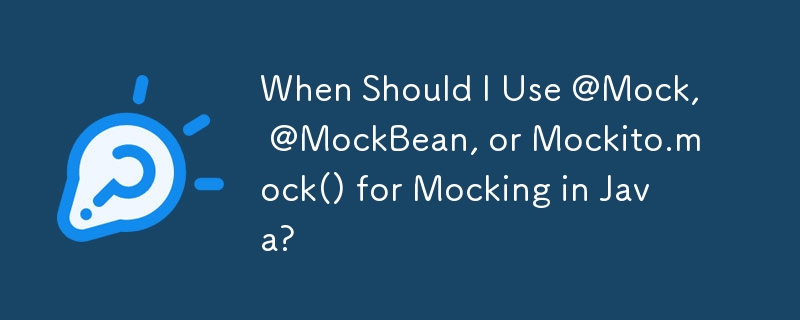When Should I Use @Mock, @MockBean, or Mockito.mock() for Mocking in Java?

Understanding the Differences between @Mock, @MockBean, and Mockito.mock()
Background
In software testing, mocking is a technique used to create fake objects that simulate the behavior of actual dependencies. Mockito is a popular mocking framework in Java that provides multiple ways to mock objects. This guide compares the different approaches and their appropriate usage.
Mockito.mock() vs @Mock (Mockito Annotations)
Mockito.mock() and @Mock are from the standard Mockito library. Both create mock objects for classes or interfaces. @Mock provides a convenient annotation-based solution, while Mockito.mock() is more explicit. In terms of functionality, they are equivalent. However, using @Mock is preferred as it simplifies the code.
@MockBean (Spring Boot)
@MockBean is a wrapper provided by the Spring Boot test library. It combines Mockito mocking capabilities with Spring's bean management. Unlike Mockito.mock() and @Mock, @MockBean creates mock beans that are injected into the Spring ApplicationContext. It has two key characteristics:
- If a bean of the same type exists in the context, it is replaced by the mock.
- If no bean of the same type exists, the mock bean is added to the context.
Usage Guidelines
When to use plain Mockito: Use Mockito.mock() or @Mock when testing components without relying on Spring Boot dependencies or when isolation of the tested component is crucial.
When to use @MockBean: Use @MockBean in web test slices (e.g., @WebMvcTest) or other testing scenarios that require modifying Spring Boot bean definitions or interacting with beans managed by the container.
Example with @MockBean
Consider a Spring Boot web test where the FooController relies on the FooService. Using @MockBean, we can replace the real FooService bean with a mock in the test context:
<code class="java">@WebMvcTest(FooController.class)
public class FooControllerTest {
@MockBean
private FooService fooServiceMock;
// ... //
}</code>In this example, the fooServiceMock instance will be injected into the FooController, allowing us to mock its behavior and control how it interacts with the controller.
The above is the detailed content of When Should I Use @Mock, @MockBean, or Mockito.mock() for Mocking in Java?. For more information, please follow other related articles on the PHP Chinese website!

Hot AI Tools

Undresser.AI Undress
AI-powered app for creating realistic nude photos

AI Clothes Remover
Online AI tool for removing clothes from photos.

Undress AI Tool
Undress images for free

Clothoff.io
AI clothes remover

Video Face Swap
Swap faces in any video effortlessly with our completely free AI face swap tool!

Hot Article

Hot Tools

Notepad++7.3.1
Easy-to-use and free code editor

SublimeText3 Chinese version
Chinese version, very easy to use

Zend Studio 13.0.1
Powerful PHP integrated development environment

Dreamweaver CS6
Visual web development tools

SublimeText3 Mac version
God-level code editing software (SublimeText3)

Hot Topics
 Is the company's security software causing the application to fail to run? How to troubleshoot and solve it?
Apr 19, 2025 pm 04:51 PM
Is the company's security software causing the application to fail to run? How to troubleshoot and solve it?
Apr 19, 2025 pm 04:51 PM
Troubleshooting and solutions to the company's security software that causes some applications to not function properly. Many companies will deploy security software in order to ensure internal network security. ...
 How to simplify field mapping issues in system docking using MapStruct?
Apr 19, 2025 pm 06:21 PM
How to simplify field mapping issues in system docking using MapStruct?
Apr 19, 2025 pm 06:21 PM
Field mapping processing in system docking often encounters a difficult problem when performing system docking: how to effectively map the interface fields of system A...
 How to elegantly obtain entity class variable names to build database query conditions?
Apr 19, 2025 pm 11:42 PM
How to elegantly obtain entity class variable names to build database query conditions?
Apr 19, 2025 pm 11:42 PM
When using MyBatis-Plus or other ORM frameworks for database operations, it is often necessary to construct query conditions based on the attribute name of the entity class. If you manually every time...
 How do I convert names to numbers to implement sorting and maintain consistency in groups?
Apr 19, 2025 pm 11:30 PM
How do I convert names to numbers to implement sorting and maintain consistency in groups?
Apr 19, 2025 pm 11:30 PM
Solutions to convert names to numbers to implement sorting In many application scenarios, users may need to sort in groups, especially in one...
 How does IntelliJ IDEA identify the port number of a Spring Boot project without outputting a log?
Apr 19, 2025 pm 11:45 PM
How does IntelliJ IDEA identify the port number of a Spring Boot project without outputting a log?
Apr 19, 2025 pm 11:45 PM
Start Spring using IntelliJIDEAUltimate version...
 How to safely convert Java objects to arrays?
Apr 19, 2025 pm 11:33 PM
How to safely convert Java objects to arrays?
Apr 19, 2025 pm 11:33 PM
Conversion of Java Objects and Arrays: In-depth discussion of the risks and correct methods of cast type conversion Many Java beginners will encounter the conversion of an object into an array...
 E-commerce platform SKU and SPU database design: How to take into account both user-defined attributes and attributeless products?
Apr 19, 2025 pm 11:27 PM
E-commerce platform SKU and SPU database design: How to take into account both user-defined attributes and attributeless products?
Apr 19, 2025 pm 11:27 PM
Detailed explanation of the design of SKU and SPU tables on e-commerce platforms This article will discuss the database design issues of SKU and SPU in e-commerce platforms, especially how to deal with user-defined sales...
 How to elegantly get entity class variable name building query conditions when using TKMyBatis for database query?
Apr 19, 2025 pm 09:51 PM
How to elegantly get entity class variable name building query conditions when using TKMyBatis for database query?
Apr 19, 2025 pm 09:51 PM
When using TKMyBatis for database queries, how to gracefully get entity class variable names to build query conditions is a common problem. This article will pin...






